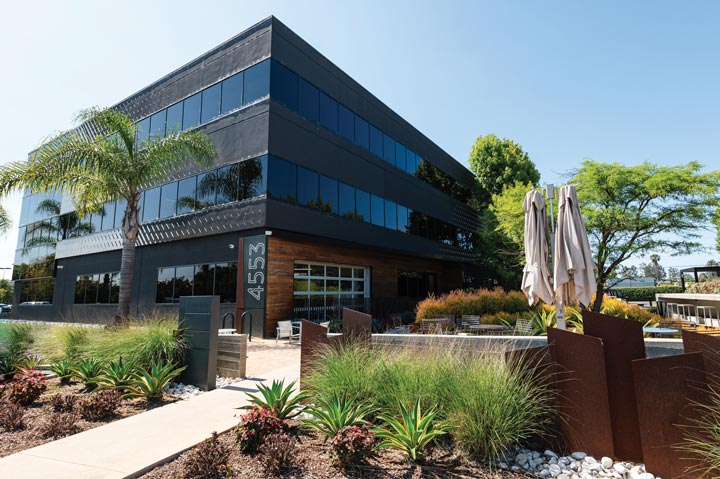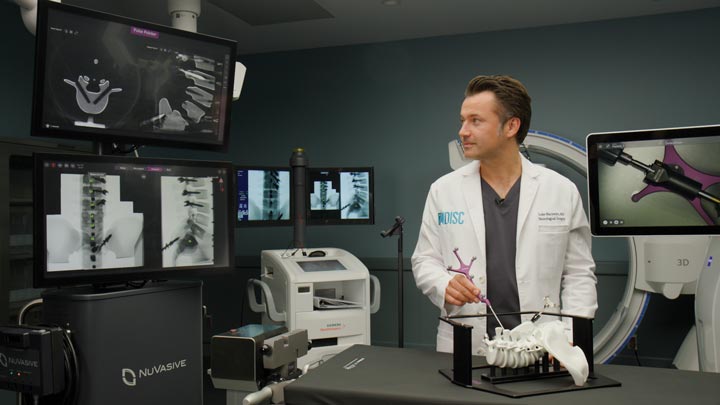- Home
- Article
Tables, Tools and Microscopes: Outfitting Your Spine Center for Success
By: Carina Stanton | Contributing Editor
Published: 2/19/2025
Use these expert strategies to get from design to launch.
Three actions can make the difference in successfully outfitting a new freestanding spine center: listening to what surgeons need, choosing the right vendors and planning with future growth in mind.
Difference-making purchases and protocols
How you divvy up the roles in equipping a new center is crucial as well, as it can make or break a successful opening more than the actual purchases of essentials such as C-arms, visualization systems and instrument sets.
For example, one person or team should be designated to purchase instruments, while a different lead should be tasked with developing and implementing clinical training protocols for the proper use and management of equipment once it’s installed. Two ASC leaders who have successfully outfitted multiple freestanding spine centers, including one that opened in 2023 and one preparing to open this year, say they followed similar roadmaps, even though one is located in Los Angeles and the other in Southern Indiana. Despite the very different markets, the strategies for selecting, installing and training on the equipment remain the same.
Equipment functionality and capability, along with surgeon buy-in, were the top priorities that influenced Luke Macyszyn, MD, FAANS, FACS, and Administrator Art Karapetyan when they outfitted the DISC Surgery Center in Marina del Rey, Calif.
The 11,000-square-foot freestanding ASC, which has been up and running for more than a year, is adjacent to DISC’s full-service orthopedic and spine clinic. The surgery center houses two state-of-the-art operating rooms outfitted with new microscopes, a post-anesthesia care bay and four private patient rooms.
From the earliest stages of the center’s design and planning, a major driver for selecting equipment was based on addressing a local need “to innovate and push forward the development of minimally invasive spine surgeries,” explains Dr. Macyszyn.
Expanding access to spine care in the community was the primary goal in constructing Advanced Surgical Institute New Albany (Ind.), according to Administrator Elaina Turner, MSN, RN, CNOR, T-CSCT, CHCM. The 15,000-square-foot new build, scheduled to open this year, was closely coordinated among Executive Director Janet Carlson, MSN, BSN, RN, CRN, E-BC, FACHE, and the project’s design, construction and clinical teams.
At both centers, leaders defined and assigned roles among the team members before they began to outfit their facilities with equipment.
Delegate tasks for equipment planning
Given the innumerable obstacles stakeholders must overcome to build a successful new surgical center, Dr. Macyszyn believes it’s vital to subdivide the various tasks and specific needs of the ASC among multiple people and groups. For example, he says a specific person or group should be responsible for selecting, trialing and purchasing OR equipment, while others should be charged with developing equipment-specific clinical protocols to ensure the new facility runs safely and efficiently. Ms. Turner agrees.
“Work as a team but have very specific duties for each individual to minimize wasted time and duplicated work,” she says.
Collect and consider physician input
Dr. Macyszyn and Mr. Karapetyan began the process for spine equipment selection at the new DISC facility by getting input from each spine surgeon who would operate there. They solicited their opinions about equipment that could push the envelope in terms of the minimally invasive techniques that could be performed at their new facility. Mr. Karapetyan says aligning those physician preferences with the center’s concurrent needs for patient and staff safety while keeping cost under control was a crucial aspect of the build process.
Dr. Macyszyn says the selection process for certain items, such as C-arms to provide the surgeon with visualization to identify correct operation levels, was relatively straightforward because the surgeons had significant experience with fluoroscopy over their careers. “Variability with this selection is relatively low,” he notes.
If only all of the equipment choices were that simple. Surgeon opinions on other items such as drills and retractor systems resulted in no clear consensus on which DISC should purchase for its new center. To narrow down its choices, Dr. Macyszyn and Mr. Karapetyan organized hands-on trials for their surgeons with potential equipment vendors to better determine which ones would best suit the needs of the majority.
Ms. Turner says it’s very important to determine what types of tables your surgeons want to use and, just as importantly, which they absolutely will not use. For example, at her facility, she and her team needed to determine whether surgeons actually needed Jackson tables.
She adds that specialty instruments should be inspected and approved by physicians when the tools arrive at the facility for the first time, and that these inspections and approvals must be performed before the instruments are sterilized. That way, they can be returned if the surgeons don’t like them.

Here are typical equipment needs to outfit a spine center, along with important purchase considerations, according to the experts interviewed for this story:
- C-arms. Acquire newer models to ensure high-quality imaging and minimize failure rates, especially when backup units are unavailable.
- Fluoroscopy arms. Variability among surgeon selection may be relatively low, but it’s still important to collect widespread surgeon input for buy-in, satisfaction and safety. Also consider how fluoroscopy arm space may be shared with a navigation system.
- Spine-specific positioning tables. Get clear input from surgeons, but also coordinate with your center’s designers and vendors to ensure ideal installation and workflow in the space.
- Instrument sets, drills and retractor systems. Standardize when possible to minimize immediate use turnovers and maximize safety.
- Distractors. Make sure physicians explain the types they will need to separate vertebrae in surgery, such as shadowline, trimline or phantom.
- Visualization equipment. Advances in these technologies should be explored carefully to determine current and future needs balanced with surgeon preference.
- Radiographic gear. This includes radiation dosage monitoring with portable shields that are accessible in the OR.
- Spine-specific supplies. Be prepared with supplies and equipment tailored to each physician’s preferences for unforeseen situations, such as excessive bleeding or dural tears.
—Carina Stanton
Choose vendors wisely

Successful equipment purchasing and implementation doesn’t just require surgeon involvement, however. It also requires building strong, collaborative partnerships with the equipment manufacturers.
Mr. Karapetyan recommends using the same vendor for spine cases as you do for traditional orthopedic cases. Limiting the number of vendors and equipment manufacturers with which it partnered enabled DISC’s Marina del Ray center to streamline equipment, turnover and maintenance, as well as staff training. “It’s also significantly more financially efficient to work with a select group of vendors in reducing costs,” notes Dr. Macyszyn.
This is particularly important when purchasing implants, retractors and navigation systems. “While we do take surgeon preference into strong consideration when making these choices, we don’t allow a complete free-for-all in terms of requests and usage of any of these kinds of purchases,” he says.
Ms. Turner suggests getting input from your physicians on what brands they prefer before speaking with vendors. “It makes sense to start with vendors that you have worked with in the past,” she says. “Even if they don’t cover spine, they typically know reps that do.”
Also be sure to inform your vendors about your facility’s future plans, as that will enable you to facilitate partnerships with vendors that will work with you as your business grows. “They will typically offer better pricing if they know they can continue to work with your company and be a preferred vendor,” says Ms. Turner.
Vendors should be able to tell you what equipment and instruments are available and how long it will take for them to be delivered after ordering. Refurbished equipment and instruments are sometimes a good option.
Meet with vendors in person whenever possible. “This helps to foster positive relationships that help ensure timely delivery of equipment and instruments,” says Ms. Turner.
Closely consider OR layout

When designing your ORs, think carefully about your needs not only at opening, but also in the future. You might only have one chance to do this right, so futureproof your ORs as best you can.
“Even if you only plan to perform minor surgeries two days a week to start, plan ahead and make sure your ORs are big enough to accommodate those larger pieces of equipment and that your structural mounts will hold lights, monitors and equipment booms,” says Ms. Turner.
Mr. Karapetyan suggests designating specific locations in your ORs for equipment such as C-arms, navigation systems, microscopes, neuro-monitoring devices and cell savers to ensure optimal workflows for your OR teams.
“This careful planning enhances efficiency and safety during procedures,” he says. “Well-designed ORs also enhance clinical productivity, limit disruptions and reduce burdens on clinical support staff.”
Align regulatory, operational planning
When opening a new spine center, know the order in which you need to submit applications to state agencies. The proper sequencing of these applications will help guide your installation plans for equipment such as MRI machines or O-arms, which might need to be installed prior to construction of walls and ceilings.
Multidisciplinary teams should review contracts, prepare Medicare applications and create staffing and other policies. Administrators should work with nurse managers to set up training for all employees on the electronic health record, equipment and workflows.
Then there are the crucial days before the center finally opens to patients.
Just prior to her center’s opening date, Ms. Turner brought the clinical and administrative teams into the facility to get acquainted with the layout as well as each other. It gave everyone the chance to familiarize themselves with new policies and procedures.
Surgeons should conduct mock surgeries using all of the equipment, instrumentation and supplies. “This has proven invaluable in preparing for live patient procedures, as it allows physicians to familiarize themselves with the new environment and equipment,” says Mr. Karapetyan. “It also instills confidence in the team, particularly for physicians who are experiencing the ASC for the first time.” OSM
.svg?sfvrsn=be606e78_3)
.svg?sfvrsn=56b2f850_5)